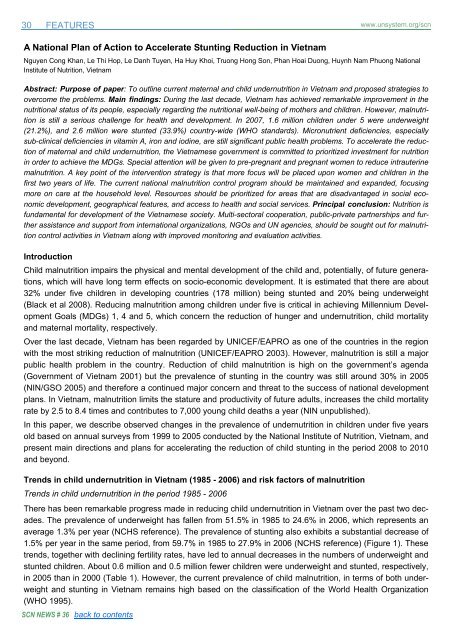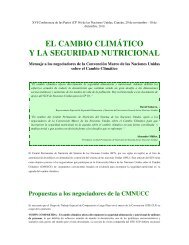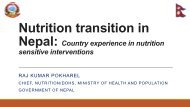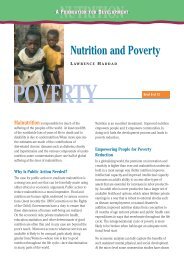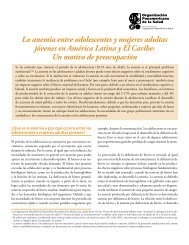SCN News No 36 - UNSCN
SCN News No 36 - UNSCN
SCN News No 36 - UNSCN
You also want an ePaper? Increase the reach of your titles
YUMPU automatically turns print PDFs into web optimized ePapers that Google loves.
30<br />
FEATURES<br />
www.unsystem.org/scn<br />
A National Plan of Action to Accelerate Stunting Reduction in Vietnam<br />
Nguyen Cong Khan, Le Thi Hop, Le Danh Tuyen, Ha Huy Khoi, Truong Hong Son, Phan Hoai Duong, Huynh Nam Phuong National<br />
Institute of Nutrition, Vietnam<br />
Abstract: Purpose of paper: To outline current maternal and child undernutrition in Vietnam and proposed strategies to<br />
overcome the problems. Main findings: During the last decade, Vietnam has achieved remarkable improvement in the<br />
nutritional status of its people, especially regarding the nutritional well-being of mothers and children. However, malnutrition<br />
is still a serious challenge for health and development. In 2007, 1.6 million children under 5 were underweight<br />
(21.2%), and 2.6 million were stunted (33.9%) country-wide (WHO standards). Micronutrient deficiencies, especially<br />
sub-clinical deficiencies in vitamin A, iron and iodine, are still significant public health problems. To accelerate the reduction<br />
of maternal and child undernutrition, the Vietnamese government is committed to prioritized investment for nutrition<br />
in order to achieve the MDGs. Special attention will be given to pre-pregnant and pregnant women to reduce intrauterine<br />
malnutrition. A key point of the intervention strategy is that more focus will be placed upon women and children in the<br />
first two years of life. The current national malnutrition control program should be maintained and expanded, focusing<br />
more on care at the household level. Resources should be prioritized for areas that are disadvantaged in social economic<br />
development, geographical features, and access to health and social services. Principal conclusion: Nutrition is<br />
fundamental for development of the Vietnamese society. Multi-sectoral cooperation, public-private partnerships and further<br />
assistance and support from international organizations, NGOs and UN agencies, should be sought out for malnutrition<br />
control activities in Vietnam along with improved monitoring and evaluation activities.<br />
Introduction<br />
Child malnutrition impairs the physical and mental development of the child and, potentially, of future generations,<br />
which will have long term effects on socio-economic development. It is estimated that there are about<br />
32% under five children in developing countries (178 million) being stunted and 20% being underweight<br />
(Black et al 2008). Reducing malnutrition among children under five is critical in achieving Millennium Development<br />
Goals (MDGs) 1, 4 and 5, which concern the reduction of hunger and undernutrition, child mortality<br />
and maternal mortality, respectively.<br />
Over the last decade, Vietnam has been regarded by UNICEF/EAPRO as one of the countries in the region<br />
with the most striking reduction of malnutrition (UNICEF/EAPRO 2003). However, malnutrition is still a major<br />
public health problem in the country. Reduction of child malnutrition is high on the government’s agenda<br />
(Government of Vietnam 2001) but the prevalence of stunting in the country was still around 30% in 2005<br />
(NIN/GSO 2005) and therefore a continued major concern and threat to the success of national development<br />
plans. In Vietnam, malnutrition limits the stature and productivity of future adults, increases the child mortality<br />
rate by 2.5 to 8.4 times and contributes to 7,000 young child deaths a year (NIN unpublished).<br />
In this paper, we describe observed changes in the prevalence of undernutrition in children under five years<br />
old based on annual surveys from 1999 to 2005 conducted by the National Institute of Nutrition, Vietnam, and<br />
present main directions and plans for accelerating the reduction of child stunting in the period 2008 to 2010<br />
and beyond.<br />
Trends in child undernutrition in Vietnam (1985 - 2006) and risk factors of malnutrition<br />
Trends in child undernutrition in the period 1985 - 2006<br />
There has been remarkable progress made in reducing child undernutrition in Vietnam over the past two decades.<br />
The prevalence of underweight has fallen from 51.5% in 1985 to 24.6% in 2006, which represents an<br />
average 1.3% per year (NCHS reference). The prevalence of stunting also exhibits a substantial decrease of<br />
1.5% per year in the same period, from 59.7% in 1985 to 27.9% in 2006 (NCHS reference) (Figure 1). These<br />
trends, together with declining fertility rates, have led to annual decreases in the numbers of underweight and<br />
stunted children. About 0.6 million and 0.5 million fewer children were underweight and stunted, respectively,<br />
in 2005 than in 2000 (Table 1). However, the current prevalence of child malnutrition, in terms of both underweight<br />
and stunting in Vietnam remains high based on the classification of the World Health Organization<br />
(WHO 1995).<br />
<strong>SCN</strong> NEWS # <strong>36</strong> back to contents


